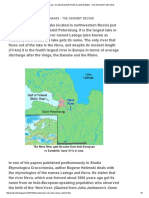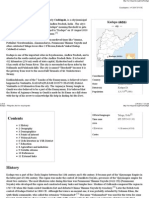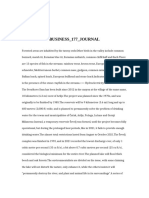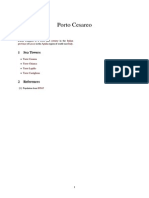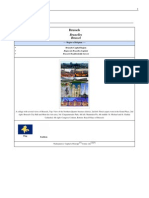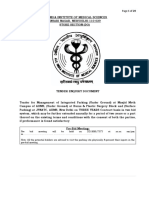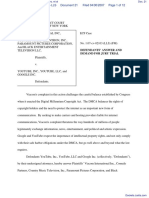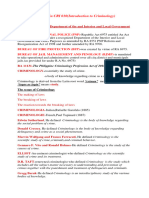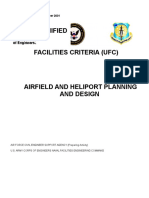Daugava River
Daugava River
Uploaded by
Josie TomodachiCopyright:
Available Formats
Daugava River
Daugava River
Uploaded by
Josie TomodachiOriginal Description:
Copyright
Available Formats
Share this document
Did you find this document useful?
Is this content inappropriate?
Copyright:
Available Formats
Daugava River
Daugava River
Uploaded by
Josie TomodachiCopyright:
Available Formats
Daugava River
Daugava River
Daugava
Origin Mouth Basin countries Length Valdai Hills, Russia Gulf of Riga, Baltic Sea Belarus, Latvia, Russia, Lithuania, Estonia 1,005km (624mi)
Source elevation 221m (725ft) Mouth elevation 0m (0ft) Avg. discharge Basin area 678m3/s (23,900cuft/s) 87,900km2 (33,900sqmi)
The River Daugava (in Latvian) or Western Dvina (Russian: (Zapadnaya Dvina); Belarusian: , [zaxodnaja dzvina], traditionally i, Dzvina; German: Dna), not to be confused with Northern Dvina, is a river rising in the Valdai Hills, Russia, flowing through Russia, Belarus, and Latvia, draining into the Gulf of Riga in Latvia, an arm of the Baltic Sea. The total length of the river is 1,005km (624mi): 325km (202mi) in Russia, 328km (204mi) in Belarus, and 352km (219mi) in Latvia.[] In the 19th century, it was connected by a canal to the Berezina and Dnieper rivers (the canal is currently not functioning). The Daugava forms part of the international border between Latvia and Belarus. According to C.Michael Hogan, the Daugava River began experiencing environmental deterioration in the era of Soviet collective agriculture (producing considerable adverse water pollution runoff) and a wave of hydroelectric power projects.
The drainage basin of the Daugava
Daugava sunset in Riga. There are three hydroelectric dams on the Daugava River Rgas HES just upstream from Riga or 35km (22mi) from the mouth of the river, egums HPP another 35km (22mi) further up or 70km (43mi) from the
Daugava River
mouth, and Pavias HPP another 37km (23mi) upstream or 107km (66mi) from the mouth. A fourth one, Daugavpils HES, has been planned but has faced strong opposition. Belarus currently plans to build several hydroelectric dams on the Belarusian part of Western Dvina.
Etymology
The Swedish army bombarding the fortress of Daugavgriva at the Daugava's estuary in Latvia.
The Latvian name for the river, "Daugava" originated from the ancient Baltic words for "the great water" (daudz dens).[citation needed] The names for the Daugava in other languages; Dyna Dwina -Dna Dvina have an unclear origin. This name is mentioned in the Viking sagas and the Chronicle of Nestor. According to the Max Vasmer's Etymological Dictionary, the toponym Dvina clearly cannot stem from a Uralic language, and it possibly comes from Indo-European word which used to mean river or stream.[1]
Cities, towns and settlements by the Daugava River
Russia
Andreapol, Zapadnaya Dvina and Velizh.
Belarus
Ruba, Vitsebsk, Beshankovichy, Polatsk with Boris stones strewn in the vicinity, Navapolatsk, Dzisna, Verkhnedvinsk, and Druya.
Latvia
Krslava, Daugavpils, Lvni, Jkabpils, Pavias, Aizkraukle, Jaunjelgava, Lielvrde, Kegums, Ogre, Ikile, Salaspils and Riga.
Crossings of the Daugava River
Belarus
Kirov Bridge, Vitebsk.
Latvia
Southern Bridge, Island Bridge, Railway Bridge, Stone Bridge and Shroud Bridge, Riga. Dams of Rgas HES, egums HPP and Pavias HPP Vienbas tilts, Daugavpils
Main tributaries
Aiviekste Paata Kasplya
Daugava River Mezha Dysna Prse
References Further reading
Richard C. Frucht; Aldis Purs. "Latvia" (http://books.google.com/books?id=lVBB1a0rC70C&pg=PA115& lpg=PA115&dq=daugava+river#v=onepage&q=daugava river&f=false). Eastern Europe (ABC-CLIO). p.115. Retrieved 2009-08-01. C.Michael Hogan. 2012. Daugava River. Encyclopedia of Earth. Eds. P.Saundry & C.J.Cleveland. National Council for Science and the Environment. Washington DC (http://www.eoearth.org/article/ Daugava_River?topic=78166)
External links
Daugava (http://geonames.nga.mil/ggmagaz/detaillinksearch. asp?G_NAME='32FA87A6CC223774E0440003BA962ED3'&Diacritics=DC) at GEOnet Names Server Coordinates: 57342N 24150E (http:/ / tools. wmflabs. php?pagename=Daugava_River¶ms=57_3_42_N_24_1_50_E_) org/ geohack/ geohack.
Article Sources and Contributors
Article Sources and Contributors
Daugava River Source: http://en.wikipedia.org/w/index.php?oldid=562272149 Contributors: 3 Lwi, Al.Neuland, Altenmann, Alykkr, Andres, Andris, Bine Mai, Blorg, CalJW, Calum Macisdean, Catalancat, Cautious, Charles01, CharlotteWebb, Chochopk, Chris the speller, ChrisGualtieri, Conversion script, Curps, Cuvette, Czalex, Darwinek, Dbenbenn, Docu, Drmies, Edgars2007, EugeneZelenko, Furfur, Gaius Cornelius, Garzo, Gene Nygaard, Ghirlandajo, Gilliam, Glossologist, Good Olfactory, Goudzovski, Green Giant, Harald Hansen, Hede2000, Ivi, Jacurek, Jan.Kamenicek, Japanese Searobin, Jayjg, Jeronimo, JohnI, Jorunn, Juha Kmrinen, Juzeris, K731, Karlis, Kelovy, Kirils, Kostja, Kuban kazak, Kukutis, Kwamikagami, LA RoeDoe, Liudininkas, Lysy, Meco, Messlo, Monk, Myasuda, Njardarlogar, Nk, P-A., Papayoung, Paukrus, Pearle, Pfly, Philaweb, Piotrus, Raider1279, Romaine, Rudidas, Serinde, Shenme, Siebrand, Spitfire, Square87, Susvolans, TenPoundHammer, TheParanoidOne, Trusilver, Trymybest, Unomano, Untifler, Urmas, Vuong Ngan Ha, Warbola, Xil, Yyy, Zemenespuu, Zscout370, .., , , 61 anonymous edits
Image Sources, Licenses and Contributors
File:Fluss-lv-Dna.png Source: http://en.wikipedia.org/w/index.php?title=File:Fluss-lv-Dna.png License: Creative Commons Attribution-Sharealike 3.0 Contributors: User:Karlis File:Riga, Daugava River.JPG Source: http://en.wikipedia.org/w/index.php?title=File:Riga,_Daugava_River.JPG License: Creative Commons Attribution-ShareAlike 3.0 Unported Contributors: Calum Macisdean, Dezidor, Man vyi File:Ustdvinsk.jpg Source: http://en.wikipedia.org/w/index.php?title=File:Ustdvinsk.jpg License: Public Domain Contributors: User:Ghirlandajo
License
Creative Commons Attribution-Share Alike 3.0 Unported //creativecommons.org/licenses/by-sa/3.0/
You might also like
- Morgan D Rosenberg - Patent Application Drafting-LexisNexisDocument757 pagesMorgan D Rosenberg - Patent Application Drafting-LexisNexisLC SHARMA100% (1)
- Order 23 Rule 3 Joint Appn For CompromiseDocument4 pagesOrder 23 Rule 3 Joint Appn For CompromiseNEHA SHARMA100% (4)
- Romix Katalog PDFDocument1 pageRomix Katalog PDFTrans ABS100% (1)
- Vishwa MitriDocument12 pagesVishwa MitriDashmeet Singh Chhabada100% (1)
- The Prophet (Peace Be Upon Him) SaidDocument21 pagesThe Prophet (Peace Be Upon Him) SaidKholoud MuhammadNo ratings yet
- The Great Rivers of Europe - DanubeDocument1 pageThe Great Rivers of Europe - Danubemihalache1977No ratings yet
- Names and EtymologyDocument9 pagesNames and EtymologyadinnnelNo ratings yet
- The DanubeDocument26 pagesThe DanubeSilviu RautaNo ratings yet
- Vedic Cafe - Scandinavian River & Lake Names - The Sanskrit DecodeDocument5 pagesVedic Cafe - Scandinavian River & Lake Names - The Sanskrit DecodeNeeta RainaNo ratings yet
- Drin River: Jump To Navigationjump To SearchDocument6 pagesDrin River: Jump To Navigationjump To SearchJohnston HowarthNo ratings yet
- The River SavaDocument7 pagesThe River SavaAleksandra TadićNo ratings yet
- Prut RiverDocument2 pagesPrut RiverMihai Florin-RazvanNo ratings yet
- Names: Names Geography History Tributaries See Also References General External LinksDocument4 pagesNames: Names Geography History Tributaries See Also References General External LinksSofroni EugenNo ratings yet
- Kupa - WikipediaDocument3 pagesKupa - WikipediaRohan GulatiNo ratings yet
- UntitledDocument1 pageUntitledSamreen AzimNo ratings yet
- 01 - SavaWhite Book StudyDocument147 pages01 - SavaWhite Book Studydalmatino16No ratings yet
- Kadapa - Wikipedia, The Free EncyclopediaDocument16 pagesKadapa - Wikipedia, The Free Encyclopediamanoj425No ratings yet
- Dnister RiverDocument4 pagesDnister RiverMihai Florin-RazvanNo ratings yet
- Rigvedic Rivers - WikipediaDocument4 pagesRigvedic Rivers - Wikipediaabcde1123No ratings yet
- T G 058 Rivers of The World Reading Comprehension Activity Ver 14Document15 pagesT G 058 Rivers of The World Reading Comprehension Activity Ver 14silmararodriguesofNo ratings yet
- Dray Sap WaterfallDocument2 pagesDray Sap Waterfallquanghieu121207No ratings yet
- Rivers of The World Reading ComprehensionDocument5 pagesRivers of The World Reading Comprehensioncarolain wallsNo ratings yet
- Djerdap National Park Guide.Document182 pagesDjerdap National Park Guide.domingezNo ratings yet
- DanubeDocument25 pagesDanubeBrave AhilesNo ratings yet
- Business 177 JournalDocument2 pagesBusiness 177 JournalBorakovsky IvanovskyNo ratings yet
- Djurokovic Hanicar Grdjan Brezak-Flood Protection ExperieDocument25 pagesDjurokovic Hanicar Grdjan Brezak-Flood Protection ExperiedcizarNo ratings yet
- Black SeaDocument43 pagesBlack SeaPeterJLYNo ratings yet
- Colorado RiverDocument2 pagesColorado RiverJDMcDougallNo ratings yet
- Karatayev Et Al 2008 Aquatic Invasions in BelarusDocument18 pagesKaratayev Et Al 2008 Aquatic Invasions in Belarusgeo_gabe_galan5473No ratings yet
- Volga River (McNeese, Tim) (Z-Library)Document127 pagesVolga River (McNeese, Tim) (Z-Library)LegrandNo ratings yet
- Fast XC Bikes Hardtail Amz or DneprDocument2 pagesFast XC Bikes Hardtail Amz or DneprWhitmireNo ratings yet
- Names and Etymology: Dānu. Other River Names From The Same RootDocument1 pageNames and Etymology: Dānu. Other River Names From The Same RootMaraBucherNo ratings yet
- Black Sea: Jump To Navigation Jump To SearchDocument4 pagesBlack Sea: Jump To Navigation Jump To SearchBogdan MateiNo ratings yet
- Natcroat 2014 23 2 KerovecDocument14 pagesNatcroat 2014 23 2 KerovecselmabegovicNo ratings yet
- Yellow River HomeworkDocument6 pagesYellow River Homeworkdbrysbjlf100% (1)
- Susquehanna RiverDocument12 pagesSusquehanna RiverFernando Avila100% (1)
- Nevada: By: Jeremiah JewellDocument25 pagesNevada: By: Jeremiah JewelljtiggsNo ratings yet
- Running Dry: A Journey From Source to Sea Down the Dying Colorado RiverFrom EverandRunning Dry: A Journey From Source to Sea Down the Dying Colorado RiverRating: 4 out of 5 stars4/5 (5)
- Ukraine For YouDocument18 pagesUkraine For YourrrNo ratings yet
- SK Facts FiguresDocument7 pagesSK Facts FiguresValibuck DumbNo ratings yet
- Water DayDocument4 pagesWater DayBondNo ratings yet
- Woman of the River: Georgie White Clark White-Water PioneerFrom EverandWoman of the River: Georgie White Clark White-Water PioneerRating: 4 out of 5 stars4/5 (1)
- Ultimate Paddling Adventures: 100 epic experiences with a paddleFrom EverandUltimate Paddling Adventures: 100 epic experiences with a paddleNo ratings yet
- North AsiaDocument28 pagesNorth AsiaRica Mae PalisocNo ratings yet
- Rivers of The WorldDocument8 pagesRivers of The WorldGhazanfar AbbasNo ratings yet
- Travel Guide: The Best Way To Enjoy A Las Vegas Travel AdventureDocument6 pagesTravel Guide: The Best Way To Enjoy A Las Vegas Travel AdventureSandra RubianoNo ratings yet
- Field Trip To Edgewater Park and Wendy Park January 2017 ReportDocument6 pagesField Trip To Edgewater Park and Wendy Park January 2017 ReportWestern Cuyahoga AudubonNo ratings yet
- Contribution To The Studies On White-Tailed Eagle (Haliaeetus Albicilla) in Western Serbia (2007)Document2 pagesContribution To The Studies On White-Tailed Eagle (Haliaeetus Albicilla) in Western Serbia (2007)Anonymous AoUv7GzNo ratings yet
- The Day Niagara Falls Stopped Running: Educational VersionFrom EverandThe Day Niagara Falls Stopped Running: Educational VersionRating: 5 out of 5 stars5/5 (1)
- Assignment - Part 1Document1 pageAssignment - Part 1api-375726143No ratings yet
- Gens de Terre RiverDocument2 pagesGens de Terre RiverJ HNo ratings yet
- Una (Sava)Document15 pagesUna (Sava)sdbitbihacNo ratings yet
- River ActionDocument47 pagesRiver Actionbaneblade1No ratings yet
- Bozanstva RijekaDocument14 pagesBozanstva Rijekadalmatino16No ratings yet
- Porto Cesareo: 1 Sea TowersDocument2 pagesPorto Cesareo: 1 Sea TowersJosie TomodachiNo ratings yet
- TbilisiDocument17 pagesTbilisiJosie Tomodachi100% (1)
- CopenhagenDocument28 pagesCopenhagenJosie TomodachiNo ratings yet
- Luxembourg (City) : Stad Lëtzebuerg Ville de Luxembourg Stadt LuxemburgDocument13 pagesLuxembourg (City) : Stad Lëtzebuerg Ville de Luxembourg Stadt LuxemburgJosie TomodachiNo ratings yet
- AthensDocument30 pagesAthensJosie TomodachiNo ratings yet
- AstanaDocument15 pagesAstanaJosie TomodachiNo ratings yet
- SofiaDocument18 pagesSofiaJosie TomodachiNo ratings yet
- ZagrebDocument25 pagesZagrebJosie TomodachiNo ratings yet
- NicosiaDocument19 pagesNicosiaJosie TomodachiNo ratings yet
- SarajevoDocument28 pagesSarajevoJosie TomodachiNo ratings yet
- BakuDocument18 pagesBakuJosie TomodachiNo ratings yet
- TiranaDocument19 pagesTiranaJosie TomodachiNo ratings yet
- BrusselsDocument23 pagesBrusselsJosie TomodachiNo ratings yet
- Paris PDFDocument35 pagesParis PDFJosie TomodachiNo ratings yet
- PragueDocument24 pagesPragueJosie TomodachiNo ratings yet
- LondonDocument41 pagesLondonJosie TomodachiNo ratings yet
- 08544/BNC VSKP SPL Sleeper Class (SL) : WL WLDocument2 pages08544/BNC VSKP SPL Sleeper Class (SL) : WL WLKrishna Prasad KanchojuNo ratings yet
- Corrected by Chairmanl TED For Parking Services at AIIMSDocument29 pagesCorrected by Chairmanl TED For Parking Services at AIIMSFathima LaisaNo ratings yet
- Committee of Council Agenda Apr 16Document150 pagesCommittee of Council Agenda Apr 16HiddenDNo ratings yet
- Android Case Study PDFDocument10 pagesAndroid Case Study PDFmadsparNo ratings yet
- Appeal Against He Order Abdul Majid Vs Mah Rukh Noor 19.10.2Document4 pagesAppeal Against He Order Abdul Majid Vs Mah Rukh Noor 19.10.2hearthacker_302No ratings yet
- Interpretation Act, 1960Document13 pagesInterpretation Act, 1960MENSAH PAULNo ratings yet
- Test 4Document3 pagesTest 4Helal Uddin100% (1)
- Viacom International, Inc. Et Al v. Youtube, Inc. Et Al - Document No. 21Document12 pagesViacom International, Inc. Et Al v. Youtube, Inc. Et Al - Document No. 21Justia.comNo ratings yet
- Brief Data Sheet: Hi3536C H.265 CODEC ProcessorDocument3 pagesBrief Data Sheet: Hi3536C H.265 CODEC ProcessoryavorNo ratings yet
- Class Exercise TensesDocument3 pagesClass Exercise TensesMarium FatimaNo ratings yet
- City of Minneapolis MPD Correspondence With MDHRDocument11 pagesCity of Minneapolis MPD Correspondence With MDHRScott JohnsonNo ratings yet
- Boardingpass ISTRATEDocument1 pageBoardingpass ISTRATEMihaela Christina PleteaNo ratings yet
- Republic Acts Relevant For LETDocument2 pagesRepublic Acts Relevant For LETAngelle Bahin100% (1)
- The Adamant SheetDocument4 pagesThe Adamant Sheetecto plasmaNo ratings yet
- Criminal Law Case Digests Art 3-6Document44 pagesCriminal Law Case Digests Art 3-6Dane DagatanNo ratings yet
- Government Intervention in International Business: by Dr. Archana SinghDocument29 pagesGovernment Intervention in International Business: by Dr. Archana Singhguptanitin1985100% (1)
- MA RMV Driver's ManualDocument158 pagesMA RMV Driver's Manualbluefish5237No ratings yet
- Union Glass Vs SECDocument3 pagesUnion Glass Vs SECNadaineNo ratings yet
- REVIEWER - P1 Exam in INTRODUCTION TO CRIMINOLOGYCRI 010Document14 pagesREVIEWER - P1 Exam in INTRODUCTION TO CRIMINOLOGYCRI 010batchobryan3No ratings yet
- EST130-Draft SchemeDocument5 pagesEST130-Draft SchemeAdarsh QclwNo ratings yet
- Gilbert Ryle - FeelingsDocument14 pagesGilbert Ryle - Feelingsmarkacohen12121No ratings yet
- Business Ethics/ Social Responsibility/ Environmental SustainabilityDocument28 pagesBusiness Ethics/ Social Responsibility/ Environmental SustainabilityEnnAoeihG PajarinNo ratings yet
- UFC - 3-260 - 01 Airfield Heliport Planning DesignDocument414 pagesUFC - 3-260 - 01 Airfield Heliport Planning DesignPricop CosminNo ratings yet
- Workplace Safety Emergency Action Plan Quiz QuestionDocument2 pagesWorkplace Safety Emergency Action Plan Quiz QuestionHassan64041No ratings yet
- The Recto and Maceda LawDocument3 pagesThe Recto and Maceda LawtumasitoeNo ratings yet
- Sarangpur ChandigarhDocument6 pagesSarangpur ChandigarhshwetaNo ratings yet










